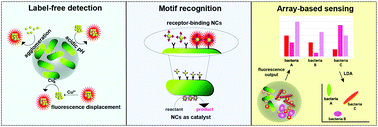Effective detection of bacteria using metal nanoclusters
Abstract
Antibiotic-resistant bacterial infections cause more than 700 000 deaths each year worldwide. Detection of bacteria is critical in limiting infection-based damage. Nanomaterials provide promising sensing platforms owing to their ability to access new interaction modalities. Nanoclusters feature sizes smaller than traditional nanomaterials, providing great sensitive ability for detecting analytes. The distinct optical and catalytic properties of nanoclusters combined with their biocompatibility enables them as efficient biosensors. In this review, we summarize multiple strategies that utilize nanoclusters for detection of pathogenic bacteria.

- This article is part of the themed collections: Recent Review Articles and Nanoscale 10th Anniversary Special Issue


 Please wait while we load your content...
Please wait while we load your content...